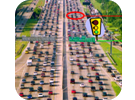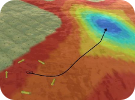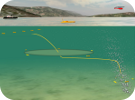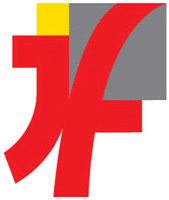TeMP
Partners: Grupo de Pesquisa em Processamento de Sinais e Informação, Universidade Federal do Ceará (Fortaleza, Brazil)
Contact: Alain Kibangou ![]()
Objectives
TeMP (tensor-based information modelling and processing) is a project funded in the framework of the French-Brazilian bilateral collaboration program (FUNCAP-INRIA); it has started in August 2011 for a duration of two years. It aims to study, analyze, propose and evaluate new models and techniques for digital communication systems using tensors and multilinear algebra tools, through in-depth theoretical analysis of mathematical models, optimization algorithms, and computational simulations. Indeed, new models should be developed for generalizing existing tensor models in order to allow for the modelling of a wider class of communication systems for more realistic propagation channels, including the cooperation among multiple nodes of a communication network (users or sensors). Due to dynamic change of parameters, tensor-based filtering algorithms need to be developed for information retrieval systems in cooperative communication; these algorithms should be distributed for avoiding network vulnerability, and for a better management of computation and storage resources.
Research actions
Distributed optimization for tensor decompositions
Multiple access protocols such as Time Division Multiple Access (TDMA) can induce a latency that can be damaging, for example, for control purposes; in this case, Direct-Sequence Code Division Multiple Access (DS-CDMA) is certainly well indicated. In the last decade, by exploiting several diversities, new signal processing techniques based on tensor modeling have been developed; with a very high efficiency, they allow the blind estimation of transmitted information sequences. In general, these works are devoted to communication systems with an antenna array at the receiver; however, many wireless devices are limited by size, hardware complexity or other constraints to a single antenna. The powerful tensor based methods cannot be applied for such nodes. In some recent papers, by resorting to the idea of collaborative signal processing, we have shown how estimating the channel, symbols, and codes in a distributed way when each node in the network has a single antenna. Since the received data samples can be stored in a three-way array, or a third-order tensor, retrieving the above mentioned unknown is equivalent to running tensor decomposition. We have already derived an average consensus-based distributed algorithm (D-ALS). The goal of this task is to:
- study the efficiency of D-ALS when each alternating least-squares step embeds single consensus iteration;
- derive a distributed Levenberg-Marquardt algorithm where some of the unknowns are strictly local;
- derive a distributed consensus algorithm by solving a constrained optimization problem by means of Lagrange multipliers method.
Centralized and distributed filtering approach for dynamic tensor decomposition
Tracking dynamic changes in a given variable (state) is the purpose of filtering and estimation. In the minimum variance sense, the optimal filter, for linear and Gaussian systems, is the so-called Kalman filter. Nonlinear extension of this filter has been derived through linearization (Extended Kalman Filter) or particles propagation (Unscented Kalman Filter). In general the state is given in vector form.; the advantage of using tensor decomposition for parameter estimation is to preserve structural algebraic properties of the tensor. Till now, dynamic tensor decomposition was not studied; our aim is to investigate the feasibility of dynamic tensor decomposition viewed as a filtering problem. Centralized schemes will first be studied; then, we will consider distributed ones. The following tasks will be achieved:
- blind estimation of time-varying FIR channels or systems using cumulants;
- blind PARAFAC receiver for non-stationary channels.
Tensor signal processing for cooperative communication systems
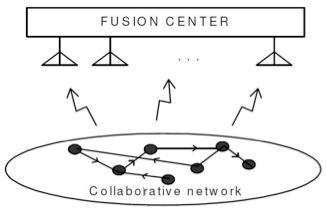 In most of studies, the spatial dimension is explored through the use of an array of transmitting and/or reception antennas; however, it is noteworthy that in modern communication systems, constraints in physical space and processing power in devices do not always allow the use of multiple antennas. One solution currently in focus is called the cooperative coding in which mobile devices share their antennas by means of a simple encoding scheme; in this case, the spatial dimension is explored with the collaboration of various network nodes. In cooperative coding schemes, one must manage the communication protocol and the technique of processing between participating nodes; in this context, we will focus on the design of tensor-based encoding and decoding algorithms for distributed cooperative MIMO systems, which consider the aspect of asynchronous cooperative networks.
In most of studies, the spatial dimension is explored through the use of an array of transmitting and/or reception antennas; however, it is noteworthy that in modern communication systems, constraints in physical space and processing power in devices do not always allow the use of multiple antennas. One solution currently in focus is called the cooperative coding in which mobile devices share their antennas by means of a simple encoding scheme; in this case, the spatial dimension is explored with the collaboration of various network nodes. In cooperative coding schemes, one must manage the communication protocol and the technique of processing between participating nodes; in this context, we will focus on the design of tensor-based encoding and decoding algorithms for distributed cooperative MIMO systems, which consider the aspect of asynchronous cooperative networks.
Tensor based for underwater acoustic OFDM systems
The channel modeling is of paramount importance in wireless communication systems: it allows translating the physical phenomena of multipath propagation in a linear or nonlinear input and output equation summarizing the changes in the wireless environment on the transmitted signals. The problem of channel estimation is strongly linked to the modeling problem, since the knowledge of the channel structure can be exploited in estimation methods and can lead to more accurate estimators; furthermore, knowledge of the correlation structure (in the case of statistical models) or the structure of the multipath (in the case of parametric models) is crucial in signaling techniques and pre-coding in MIMO systems. In most approaches in the literature, the modeling exhibit restrictions and simplifications such as:
- propagation delay of the received signal along the antennas comprising the array is considered negligible and not included in the CP model for the multipath channel;
- a uniform and linear antenna array in which only the azimuth plane is considered for characterizing the angle of arrival of multipaths (the elevation plane is discarded);
- idealized models for the temporal variation of the multipath channel is considered;
- idealized models for power amplifiers are considered.
Our aim is to go further in the study of such systems by discarding some of unrealistic assumptions; in addition, we will also study the particular case of underwater acoustic channels where tensor approaches have not yet been considered. In the algorithmic point of view study and development of algorithms based on simultaneous matrix diagonalization for tensor decomposition will be investigated.
Selected papers
- A. L. F. De Almeida, A. Y. Kibangou, D. C. Araujo and S. Miron, Joint data and connection topology recovery in collaborative wireless sensor network, submitted to IEEE Conference on Acoustic, Speech and Signal Processing, 2013.
- A. Y. Kibangou and A. L. F. De Almeida, Distributed Khatri-Rao space-time coding and decoding for cooperative networks, 19th European Signal Processing Conference (EUSIPCO 2011), 2011.
- A. Y. Kibangou and A. L. F. De Almeida, Distributed PARAFAC based DS-CDMA blind receiver for wireless sensor networks, 11th IEEE International Workshop on Signal Processing Advances in Wireless Communications, 2010.
 Go to the full list of publications
Go to the full list of publications

